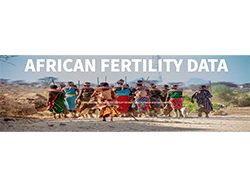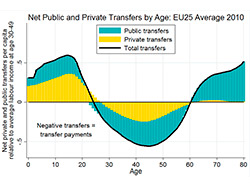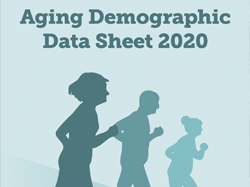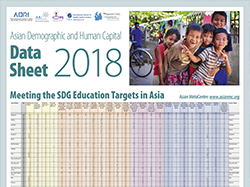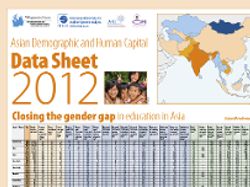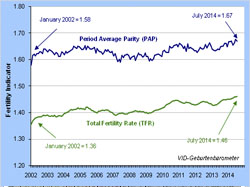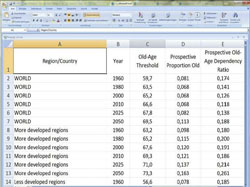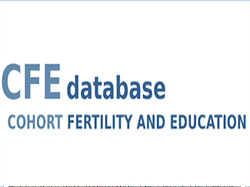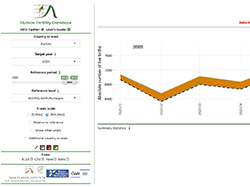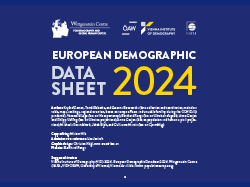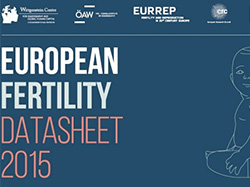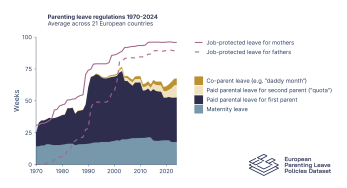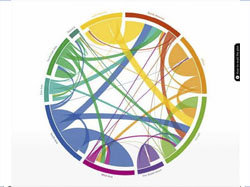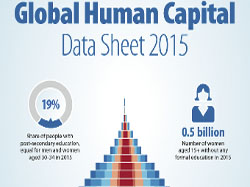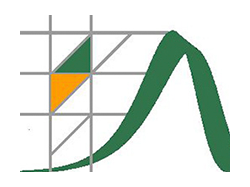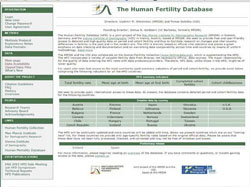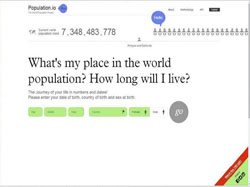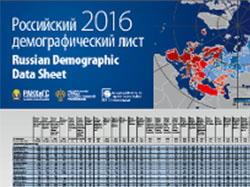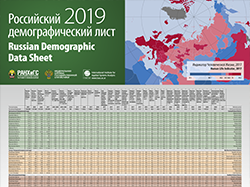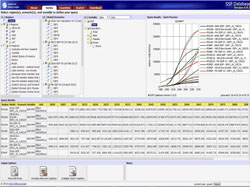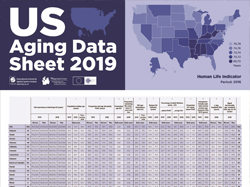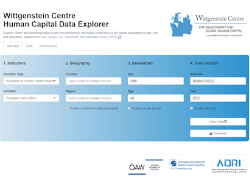African Fertility Data
This app is an extension of the Bayesian Reconstruction of Populations and Vital Rates by Educational Attainment (BayesEdu) project, number IF_2019_29. The aim of the project is to combine available demographic data to provide true estimates of population sizes, and vital rates by educational attainment with uncertainty around them. Funded from the Innovation Fund Research, Science and Society by the Austrian Academy of Sciences (OEAW).
MoreAGENTA Data Explorer
The AGENTA data explorer allows the investigation and download of European National Transfer Accounts (NTA) and National Time Transfer Accounts (NTTA) data. European NTA provide comprehensive and detailed age- and gender specific economic data on income, transfers, consumption and saving for 25 European countries. European NTTA include time use based estimates for production, transfers and consumption of services produced by unpaid work for 17 EU countries.
MoreAging Demographic Data Sheet 2020
The Aging Demographic Datasheet 2020 shows population aging trends and projections with a focus on traditional and alternative indicators of population aging for the current and future population changes across the world.
MoreAsian Demographic and Human Capital Data Sheet 2018
The Asian data sheet provides a window on indicators related to demographic changes and education processes in the countries of the region. It also includes data on labor force participation and urbanization. For each indicator, the data sheet allows a comparison between three data points: 2000, 2015 and 2030 according to a medium scenario projection.
MoreAsian Demographic Data Sheets 2012, 2008
The data sheets provide information on a range of demographic indicators from fertility to ageing to education levels for countries in Asia.
MoreBirth Barometer: Monitoring of Fertility in Austria
Birth Barometer Austria and Birth Barometer Vienna (launched in May 2010) are interconnected projects of the Vienna Institute of Demography, aiming to provide continuous monitoring of period fertility rates in Austria and in Vienna. The Birth Barometer provides quarterly and annual reports and regularly updated datasets.
MoreCharacteristics Approach to Population Aging: New Measures (Version 2, December, 2015)
New measures of population aging based on a dynamic view of how the characteristics of the elderly change now available for downloading.
MoreCohort Fertility and Education (CFE) Database
The Cohort Fertility and Education (CFE) database provides high-quality data on completed cohort fertility and parity distribution by level of education. The data come from censuses and large sample surveys, and cover several (mostly European) countries, i.e. countries with generally high levels of education and relatively low fertility. As the database is in a constant progress, data from new countries and sources are being regularly added.
MoreCOVID-19: New Database and Visualisation Tool on Short-Term Fertility Fluctuations (STFF)
This joint project with the Max Planck Institute for Demographic Research in Rostock aims to analyse short- and longer-term consequences of the COVID-19 pandemic on the trends in the number of births and fertility rates in high-income countries with good quality of vital statistics data. In response to the COVID-19 pandemic, the HFD team established a new data resource: Short-Term Fertility Fluctuations (STFF) data series.
MoreEuropean Demographic Data Sheet 2024
The European Demographic Data Sheets show key demographic data, population trends and projections. The latest version (2024) focuses on population trends in times of crises.
Previous editions of the European Demographic Data Sheet poster are available here.
MoreEuropean Fertility Data Sheet 2015
The European Fertility Datasheet 2015 provides an in-depth look at European fertility through a combination of data for all countries of Europe and for broader European regions, maps, tables, graphs and featured thematic boxes. The online version is optimized for mobile devices and provides expanded coverage, including additional maps, ranking charts as well as details about data sources and definitions. It also allows the users to download all the data.
MoreThe European Parenting Leave Policies (EPLP) Dataset
The European Parenting Leave Policies (EPLP) Dataset provides harmonised data on maternity, co-parent, paid parental, and job-protected leave regulations across 21 European countries from 1970 to 2024. These policies shape how long birth mothers and co-parents can be away from paid work around childbirth, and how leave can be shared between them. By covering 33 variables on leave duration, benefits, flexibility, and incentives for sharing leave between couples, the dataset enables quantitative analyses of policy trends, cross-national differences, and the effects of major reforms – for researchers, policymakers, and others interested in family policy.
MoreGlobal flow of people
We introduce estimates for bilateral global migration flows between all countries in the world. Explore in the interactive website at http://global-migration.info/. There is also a link on the website to download all the data, including the paper on Quantifying Global International Migration Flows published in Science.
MoreGlobal Human Capital Data Sheet 2015
The Global Human Capital Data Sheet 2015 presents new population projections by age, sex, and level of educational attainment for the world, world regions, and 195 individual countries (24 countries with limited education data) with a time horizon to 2060.
The Wittgenstein Centre provides a new visualization tool for presenting population projections by age, sex, and level of educational attainment for the world with a time horizon to 2060. More
Visualization of the Global Human Capital Data Sheet 2015
MoreHousehold surveys after the 2012 Indian Ocean Earthquake in Phang Nga (Thailand)
This dataset is based on a survey of households located in tsunami high-risk areas in Phang Nga province. The purpose of the survey is to investigate household responses to the Indian Ocean Earthquakes (M8.6) on 11 April 2012. The survey was conducted by the College of Population Studies, Chulalongkorn University between 17 April - 13 May 2012.
MoreHuman Fertility Collection
The Human Fertility Collection (HFC) is a joint project of the Max Planck Institute for Demographic Research (MPIDR) in Germany and the Vienna Institute of Demography (VID) in Austria. The HFC has been designed to supplement the Human Fertility Database (HFD) and to incorporate a variety of international fertility data that are valuable for fertility research but do not meet all quality standards of the HFD.
MoreHuman Fertility Database
The Human Fertility Database (HFD) is a joint project of the Max Planck Institute for Demographic Research (MPIDR) in Rostock, Germany and the Vienna Institute of Demography (VID) in Vienna, Austria, based at MPIDR. We seek to provide free and user-friendly access to detailed and high-quality data on period and cohort fertility and thus to facilitate research on changes and inter-country differences in fertility in the past and in the modern era. The HFD is entirely based on official vital statistics and places a great emphasis on data checking and documentation and on warranting data comparability across time and countries by means of uniform methodology. Read more
MoreJourney of your life - Website
Samir KC together with colleagues from the World Bank have developed an interactive tool to help individuals see their place in the world population, http://population.io/. The website reflects the most up to estimates of life expectancy for each country as well as for the world as a whole, but limited to three factors: existing age, gender and country of birth/residence. Read more about it in the IIASA blog Journey of your life: Demography for the demos.
MoreNational Transfer Accounts
The goal of the National Transfer Accounts (NTA) project is to improve our understanding of the generational economy. How does population growth and changing age structure influence economic growth, gender and generational equity, public finances, and other important features of the macroeconomy? As part of the NTA project, research teams in more than 40 countries are constructing accounts, measuring how people at each age produce, consume, and share resources, and save for their future. The accounts are designed to complement the UN System of National Accounts, population data, and other important economic and demographic indicators.
MoreRussian Demographic Data Sheet 2016
The Russian Demographic Datasheet 2016 shows key demographic data, population trends and projections until 2035. It covers fertility, mortality, migration, population structure including population ageing and their changes. The datasheet combines data for the national level, all regions and districts, and features maps, population pyramids, rankings, graphs and a glossary. It pays special attention to the importance of alternative indicators of population ageing for the current and future population changes across Russia. All information is provided in both languages, Russian and English.
MoreRussian Demographic Data Sheet 2019
The Russian Demographic Data Sheet 2019 shows key demographic data, population trends and projections until 2050. It covers fertility, mortality, migration, population structure including population ageing and their changes. The data sheet combines data for the national level, all regions and districts, and features maps, population pyramids, rankings, graphs and a glossary. It pays special attention to the importance of alternative indicators of population ageing for the current and future population changes across Russia. All information is provided in both languages, Russian and English.
MoreSSP Database Version 1.0
The SSP database aims at the documentation of quantitative projections of the so-called Shared Socioeconomic Pathways (SSPs) and related Integrated Assessment scenarios. The SSPs are part of a new framework that the climate change research community has adopted to facilitate the integrated analysis of future climate impacts, vulnerabilities, adaptation, and mitigation. Information about the scenario process and the SSP framework can be found in Moss et al. (2010), van Vuuren et al. (2014) and O‘Neil et al. (2014) and Kriegler et al. (2014). The framework is built around a matrix that combines climate forcing on one axis (as represented by the Representative Concentration Pathways: van Vuuren et al, 2011 ) and socio-economic conditions on the other. Together, these two axes describe situations in which mitigation, adaptation and residual climate damage can be evaluated.
MoreUnited States Aging Data Sheet 2019
The first US Aging Data Sheet comprehensively presents traditional and new measures of aging, developed at IIASA, for all US states. This data sheet uses the United States Mortality DataBase to analyze aging across US states by: (1) contrasting conventional measures of aging with new ones based on The Characteristics Approach to the Measurement of Population Aging, and (2) providing new measures that are particularly appropriate for the current US context.
MoreWIREL Database
WIREL was a research project (funded by the Vienna Science and Technology Fund) that studied different demographic and religious forces that have shaped Vienna’s population composition throughout the past as well as the implications that such forces hold for the present and the future.
MoreWittgenstein Centre Human Capital Data Explorer
The Wittgenstein Centre Human Capital Data Explorer contains detailed data by age, sex and educational attainment (6 categories and up to 8 for 60 countries) for a large set of indicators w.r.t. Population and Human Capital Stocks, Demographic Change and New aging indicators of some 200 countries (and regions) for the period from 1950 to 2100. This website presents a set of different scenarios of future population and human capital trends from 2015 to 2100 and includes back projections from 2015 to 1950. The Graphic Explorer allows to visualize population pyramids and the population size by education for any country and to create maps about the available indicators.
MoreThe Wittgenstein Centre aspires to be a world leader in the advancement of demographic methods and their application to the analysis of human capital and population dynamics. In assessing the effects of these forces on long-term human well-being, we combine scientific excellence in a multidisciplinary context with relevance to a global audience. It is a collaboration among the Austrian Academy of Sciences (ÖAW), the International Institute for Applied Systems Analysis (IIASA) and the University of Vienna.

